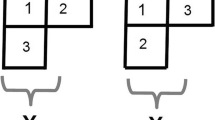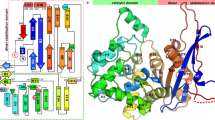Abstract
THE structure of asparagine has been discussed several times during recent years1–5. A number of properties would be better explained by a ring structure than by the conventional straight-chain structure1,2, but on the other hand, the carboxylic group had to be free3. The structure of crystalline asparagine monohydrate has now been determined by us with X-rays, and although this does not give definite information about the structure of the molecule in solution, it does give some indications about it.
This is a preview of subscription content, access via your institution
Access options
Subscribe to this journal
Receive 51 print issues and online access
$199.00 per year
only $3.90 per issue
Buy this article
- Purchase on Springer Link
- Instant access to full article PDF
Prices may be subject to local taxes which are calculated during checkout
Similar content being viewed by others
References
Steward, F. C., and Thompson, J. F., Nature, 169, 739 (1952).
Evstigneeva, Z. G., and Kretovich, V. L., Doklady Akad. Nauk, S.S.S.R., 93, 1069 (1953); Chem. Abs., 48, 4602h (1954).
Davies, M., and Evans, J. C., J. Chem. Soc., 480 (1953).
Saidel, L. J., Nature, 172, 955 (1953).
Katz, L., Pasternak, R. A., and Corey, R. B., Nature, 170, 1066 (1952).
Handbook of Chemistry and Physics (1955–56).
Author information
Authors and Affiliations
Rights and permissions
About this article
Cite this article
KARTHA, G., DE VRIES, A. Structure of Asparagine Monohydrate. Nature 192, 862–863 (1961). https://doi.org/10.1038/192862a0
Issue Date:
DOI: https://doi.org/10.1038/192862a0
This article is cited by
-
Comments on “Investigation on synthesis, laser damage threshold, and NLO properties of l-asparagine thioacetamide single crystal for photonic device applications” [J Mater Sci: Mater Electron. 31, 13310–13320 (2020)]
Journal of Materials Science: Materials in Electronics (2021)
-
Resolution of conglomerates by stereoselective habit modifications
Nature (1982)
-
Influence of the hydrogen bond on the N-H stretching frequencies in amino-acids
Proceedings of the Indian Academy of Sciences - Section A (1964)
-
Raman spectrum ofl-asparagine monohydrate
Proceedings of the Indian Academy of Sciences - Section A (1962)
Comments
By submitting a comment you agree to abide by our Terms and Community Guidelines. If you find something abusive or that does not comply with our terms or guidelines please flag it as inappropriate.



